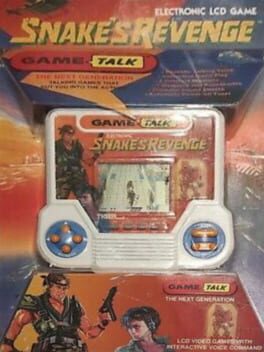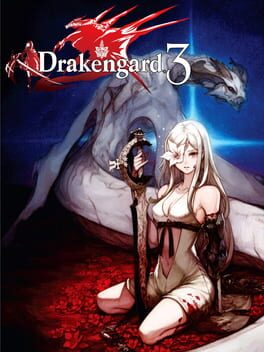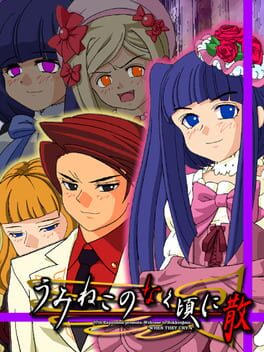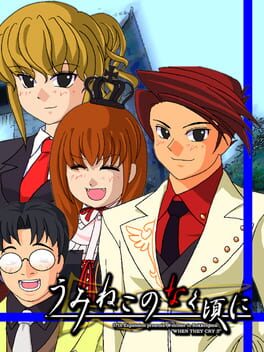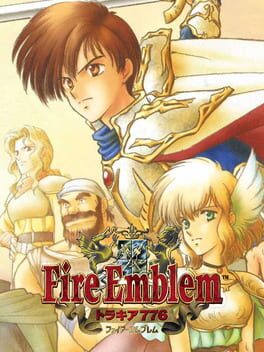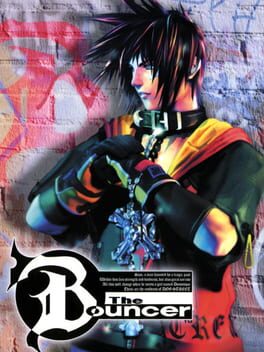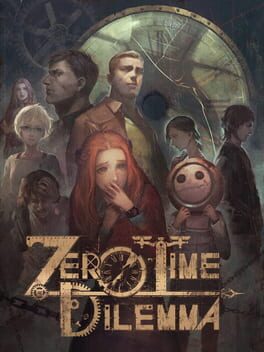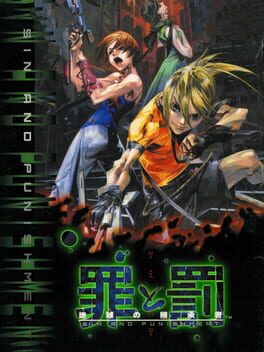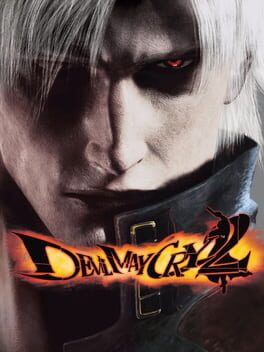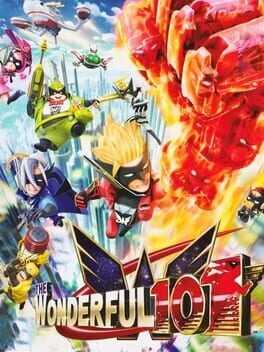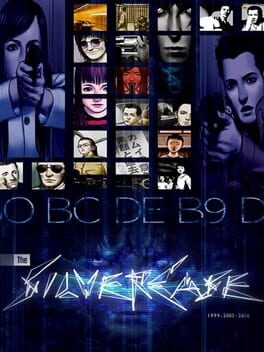PhantasyGanime
84 Reviews liked by PhantasyGanime
Snake's Revenge
1990
Drakengard 3
2013
Kaga: It’s not a big problem if some of your characters die in Fire Emblem; I want each player to create their own unique story. Don’t get caught up trying to get a “perfect ending.” Have fun!
Fire Emblem’s synthesis of two core ideas - RPG elements and permadeath - work together as a powerful combination for creating unique experiences. Different units will grow in different ways and between the dicerolls and each player’s personal preference, they’ll end up with armies that look and function largely differently from each other. Throwing an extra curveball in this is permadeath, as poor planning or just plain rotten luck can lead to favourite units dying and being unavailable for the rest of the game, with the consequence usually being to try training a new unit - likely one you didn’t have much attachment to in the first place - bringing further diversity as well as a new story to tell.
Thracia 776 is by far and away the best Fire Emblem game at creating these emergent stories. The first reason is that it’s easily the most freeform game in the series for a number of reasons. Stat caps are fairly low and growths can be boosted by holding Crusader Scrolls, letting just about any character be endgame-viable if you want to put the work in as well as making it easier to train up a new unit to recover from a particularly crushing loss. Other factors like skills, personal weapons, movement stars and FCM, as well as the fabled movement growth, keep everyone feeling unique and give you something to get attached to. All these tools bring the gameplay to feel incredibly open - while Thracia has a well-earned reputation as the “staff game”, as status staves are just as hilariously overpowered as they are hilarious to use, it’s more just the most easily-observable result of this. The game gives you so many powerful tools - between items like insane personal weapons and staves, as well as mechanical tools like Canto and infinite trading - that there’s so much individuality and expression in how you approach a chapter or weasel yourself through tight situations, which is only compounded by how uniquely any one person’s army is going to fall together. Fatigue seems like it would take away from this uniqueness by forcing everyone to use most of the characters across the game, but it makes each chapter’s potential difficulty and solution vary even more depending on when you have access to your strongest units.
The second is its tendency towards surprises, and though the aforementioned movement stars and movement levels, as well as the tendency of crits to skew heavily in your favour, all play into this, its more interesting display is shown through its chapter design. Thracia’s design mentality would be absolutely aggravating in any other game, as each chapter aims to properly convey the situation that Leif’s army finds itself in - this means it often puts you in heavily disadvantageous positions and loves to throw heavy curveballs at you as the chapters’ stories advance and the opposition’s own plans advance alongside yours. What makes this feel reasonable in Thracia is the sheer strength and number of tools you have to navigate around these tricks. They will catch you off guard - and likely steal some of your soldiers away from you - but they rarely felt outright unfair, instead feeling like I could have prepared better, or could have played better. Chapters often feel like real opponents constantly trying to keep you on your toes, and while it’s crushing to lose a strong unit to something you didn’t expect, the stakes make it even more satisfying to defy the odds.
Its story compounds those themes held up by the gameplay, as while the broad strokes involve the reclamation and unification of an entire country, the details focus on the people of the story, their victories and losses, their choices and resulting consequences, their perseverance or lack thereof. Leif’s inexperience leads him to struggle to lead the Liberation, making multiple brash mistakes that set back his goals and get those close to him killed, as he stumbles forward in pursuit of a personal goal that almost none of the other fighters can even relate to, all while being overshadowed by the fighters beyond the borders. It’s his perseverance, in spite of all his losses and heartbreak, that leads him to eventually recapture Munster from the Empire. Just as Leif’s own quest is imperfect, the game expects yours to be, as not only can multiple events only be seen with certain characters kept alive, but small details change when certain characters *die* - Leif can even fail to achieve his own strongest motivation if the right mistakes are made. Why bother implementing these, if not for these losses being an expected part of the experience?
After all, if everyone’s story was perfect, nobody’s story would be unique.
Fire Emblem’s synthesis of two core ideas - RPG elements and permadeath - work together as a powerful combination for creating unique experiences. Different units will grow in different ways and between the dicerolls and each player’s personal preference, they’ll end up with armies that look and function largely differently from each other. Throwing an extra curveball in this is permadeath, as poor planning or just plain rotten luck can lead to favourite units dying and being unavailable for the rest of the game, with the consequence usually being to try training a new unit - likely one you didn’t have much attachment to in the first place - bringing further diversity as well as a new story to tell.
Thracia 776 is by far and away the best Fire Emblem game at creating these emergent stories. The first reason is that it’s easily the most freeform game in the series for a number of reasons. Stat caps are fairly low and growths can be boosted by holding Crusader Scrolls, letting just about any character be endgame-viable if you want to put the work in as well as making it easier to train up a new unit to recover from a particularly crushing loss. Other factors like skills, personal weapons, movement stars and FCM, as well as the fabled movement growth, keep everyone feeling unique and give you something to get attached to. All these tools bring the gameplay to feel incredibly open - while Thracia has a well-earned reputation as the “staff game”, as status staves are just as hilariously overpowered as they are hilarious to use, it’s more just the most easily-observable result of this. The game gives you so many powerful tools - between items like insane personal weapons and staves, as well as mechanical tools like Canto and infinite trading - that there’s so much individuality and expression in how you approach a chapter or weasel yourself through tight situations, which is only compounded by how uniquely any one person’s army is going to fall together. Fatigue seems like it would take away from this uniqueness by forcing everyone to use most of the characters across the game, but it makes each chapter’s potential difficulty and solution vary even more depending on when you have access to your strongest units.
The second is its tendency towards surprises, and though the aforementioned movement stars and movement levels, as well as the tendency of crits to skew heavily in your favour, all play into this, its more interesting display is shown through its chapter design. Thracia’s design mentality would be absolutely aggravating in any other game, as each chapter aims to properly convey the situation that Leif’s army finds itself in - this means it often puts you in heavily disadvantageous positions and loves to throw heavy curveballs at you as the chapters’ stories advance and the opposition’s own plans advance alongside yours. What makes this feel reasonable in Thracia is the sheer strength and number of tools you have to navigate around these tricks. They will catch you off guard - and likely steal some of your soldiers away from you - but they rarely felt outright unfair, instead feeling like I could have prepared better, or could have played better. Chapters often feel like real opponents constantly trying to keep you on your toes, and while it’s crushing to lose a strong unit to something you didn’t expect, the stakes make it even more satisfying to defy the odds.
Its story compounds those themes held up by the gameplay, as while the broad strokes involve the reclamation and unification of an entire country, the details focus on the people of the story, their victories and losses, their choices and resulting consequences, their perseverance or lack thereof. Leif’s inexperience leads him to struggle to lead the Liberation, making multiple brash mistakes that set back his goals and get those close to him killed, as he stumbles forward in pursuit of a personal goal that almost none of the other fighters can even relate to, all while being overshadowed by the fighters beyond the borders. It’s his perseverance, in spite of all his losses and heartbreak, that leads him to eventually recapture Munster from the Empire. Just as Leif’s own quest is imperfect, the game expects yours to be, as not only can multiple events only be seen with certain characters kept alive, but small details change when certain characters *die* - Leif can even fail to achieve his own strongest motivation if the right mistakes are made. Why bother implementing these, if not for these losses being an expected part of the experience?
After all, if everyone’s story was perfect, nobody’s story would be unique.
The Bouncer
2000
escrevi em inglês sobre esse jogo e o modo como a moda era usada para mascarar a sua classe social nos anos 2000: https://www.superjumpmagazine.com/the-bouncer-is-a-fashion-statement/
Drakengard 3
2013
Sin and Punishment
2000
an adaptation of the fevered sugar-fueled scribblings in the margins of your maths textbook, impossible battles and astonishing reveals and incredible images streamed directly from the imagination of a bored 11-year old. zero restraint, zero conception of what is and is not "enough", pulling from all the things they love with reckless abandon, rendered with all the technical mastery of one of the most legendary studios in the industry at the height of their powers.
sin and punishment reeks of a dense inner mythology that it almost never lets the viewer peer into, not so much beginning in media res but existing almost entirely in the head of it's creator, assuming an understanding that could only be found inside there. i mean this as the highest possible praise, sin and punishment channels an effortlessly positive adolescent enthusiasm that other games could only dream of replicating. pairing this with an understanding of cinematic technique in gameplay years ahead of the curve, turn-of-the-millennium eco-warrior themes screamed loud enough to be heard above the glorious cacophony, a beautiful tapestry of rail shooting that entices perfection like few other games manage and what else could Sin and Punishment possibly do? what more could we possibly ask for?
well, one of the best final bosses that video games have ever seen certainly helps.
A warning from Beyond The Time, from futures wrapped in themselves: Kill the future they say Must Be. Preferably with a gunblade.
sin and punishment reeks of a dense inner mythology that it almost never lets the viewer peer into, not so much beginning in media res but existing almost entirely in the head of it's creator, assuming an understanding that could only be found inside there. i mean this as the highest possible praise, sin and punishment channels an effortlessly positive adolescent enthusiasm that other games could only dream of replicating. pairing this with an understanding of cinematic technique in gameplay years ahead of the curve, turn-of-the-millennium eco-warrior themes screamed loud enough to be heard above the glorious cacophony, a beautiful tapestry of rail shooting that entices perfection like few other games manage and what else could Sin and Punishment possibly do? what more could we possibly ask for?
well, one of the best final bosses that video games have ever seen certainly helps.
A warning from Beyond The Time, from futures wrapped in themselves: Kill the future they say Must Be. Preferably with a gunblade.
Desert Bus
2011
Devil May Cry 2
2003
The Devil May Cry games, and arguably action games as a whole, wouldn't be what they are today without DMC2. Everyone knows it's bad, but I think there's an unfortunate tendency to gloss over what an important piece of action game history it is. Few games are as absolutely brimming with legitimately really good and innovative ideas as DMC2 is, it's just that it didn't have anywhere near the development time it needed to realise them. Because of this, I think it's much more interesting to look at DMC2 in terms of what it did well & why it's ultimately much more influential than one would initially assume.
So, what did DMC2 bring to the table? Among other things, we've got:
- Instant weapon switching (albeit only for guns, but a paradigm-shifting precedent regardless).
- Prototypes of what would later become Styles; dodging & wallrunning were refined into Trickster, the air combo into Swordmaster, Rainstorm and Twosome Time into Gunslinger, etc.
- Bloody Palace, which pretty much every 3D action game worth its salt has a loose equivalent of.
- Majin Devil Trigger, which eventually led to Sin Devil Trigger (i.e. the coolest thing ever) in DMC5.
- A level select menu, which is probably taken for granted now.
- Multiple playable characters, which became enough of a series staple that it's effectively the main selling point of DMC3, 4 and 5's Special Editions.
- Customisation of your equipment in the form of amulets, which carried over into DMC3 and was eventually taken to an unparalleled extreme in DMC5.
Make no mistake: DMC2 is atrocious. But if not for its existence, both the DMC series itself & action games in general would be unrecognisable. For that reason, I think DMC2 is worth experiencing for yourself, even if you understandably don't finish it. You probably won't enjoy it, but you will inevitably gain a greater appreciation for why the games that came after this are as good as they are. Hideaki Itsuno and the rest of the developers under him probably deserve more credit for salvaging and expanding upon virtually every ounce of potential that this game had.
So, what did DMC2 bring to the table? Among other things, we've got:
- Instant weapon switching (albeit only for guns, but a paradigm-shifting precedent regardless).
- Prototypes of what would later become Styles; dodging & wallrunning were refined into Trickster, the air combo into Swordmaster, Rainstorm and Twosome Time into Gunslinger, etc.
- Bloody Palace, which pretty much every 3D action game worth its salt has a loose equivalent of.
- Majin Devil Trigger, which eventually led to Sin Devil Trigger (i.e. the coolest thing ever) in DMC5.
- A level select menu, which is probably taken for granted now.
- Multiple playable characters, which became enough of a series staple that it's effectively the main selling point of DMC3, 4 and 5's Special Editions.
- Customisation of your equipment in the form of amulets, which carried over into DMC3 and was eventually taken to an unparalleled extreme in DMC5.
Make no mistake: DMC2 is atrocious. But if not for its existence, both the DMC series itself & action games in general would be unrecognisable. For that reason, I think DMC2 is worth experiencing for yourself, even if you understandably don't finish it. You probably won't enjoy it, but you will inevitably gain a greater appreciation for why the games that came after this are as good as they are. Hideaki Itsuno and the rest of the developers under him probably deserve more credit for salvaging and expanding upon virtually every ounce of potential that this game had.
The Wonderful 101
2013
Taking notes from the Tokusatsu flavor of Japanese capeshit, Hideki Kamiya didn’t just want to blow the roof off of his last superhero game, he wanted to blast a hole in the ozone layer and cruise on the border the farthest reaches of the cosmos. He’s never been content with just shooting for the stars, but this title more than any other feels like the truest expression of what he’s wanted to achieve with his games. Having a massive team of action game legends and publisher money from Nintendo all but ensured that the final product would come out with a Platinum-like sheen of creative polish, but as far as I can tell, The Wonderful 101 still managed to impress almost anyone who gave it the time of day in a way nobody was really expecting. There’s a reason the game is still, generally speaking, regarded as one of the highlights of the Wii U. In 2020, it even managed to conjure over $1.5 million in an effort to port it to modern platforms, absolutely crushing the goals set by its Kickstarter.
Naturally, it crashed and burned on release.
The game bombed hard. I don’t envy the position of trying to market the damn thing to general consumers, but on top of the comparatively-niche appeal of the action genre and an aesthetic that repulsed many who laid eyes on it, The Wonderful 101 also didn’t make the experience of getting into it very easy. It wasn’t universally panned by critics or anything - in fact it reviewed pretty well considering how low its sales were - but it’s fair to say most people didn’t get it. Speaking personally, it took me multiple attempts on two different platforms to get past the on-ramp, and even beyond that point it took some time to really click with me.
It’s a real shame having so many of its players bounce off the experience before they can even experience a fraction of what it had to offer, but I almost don’t blame them, at least in retrospect. It's a title that gives out what you put in, possibly more than any other game I’ve ever played. Not everyone is gonna be willing to sit down and give something this mechanically-abrasive a chance, especially if it wears the façade of being nothing but a kid friendly Nintendo romp. Late-teens dudebros aren’t gonna give it their attention, and It probably isn’t a game for grandma either, I get it. Having said that, I don't want this piece to scare anyone off from the game, far from it. If you’ve read this far you surely care about or are interested in the game in some regard (or have played the game before, in which case this specific passage isn’t super important (or just likehearing reading what I have to say ❤)), so if you haven’t closed the tab yet, hear me out:
I don’t generally like picking my absolute favorite things, it's way easier to just provide a list of things I love than to comfortably settle down with one thing, but this is kinda the exception. Without question, if you asked me what my favorite game is, the answer would be an easy one. The Wonderful 101 has it all for me: a colorful cast of characters, a gameplay loop I can’t find anywhere else, indulgent yet tasteful callbacks to the history of the medium of games, a heartfelt story, a campaign that never loses its luster, and a finale I can only describe as legendary. It’s the complete package. Some games may do individual things better, but no game does it all with quite as much fanfare. I unabashedly love it, and I want as many people as possible to give it a fair chance (or two), just as I did. The best things in life don’t come without hardships, after all.
Video games, especially those in 3D spaces, have often struggled to consistently convey critical information to the player when it's most often needed, and it's easy to see why. How do you give the player enough time to react to something coming into frame in a fast paced platformer or a racer? How do you differentiate a hole in the ground from being a safe drop or an instant death trap? Many potential issues can be alleviated through smart signposting and subtle signals to the player, but it feels like action games in particular have struggled with cameras more than most genres. All too often it's extremely challenging to keep everything in focus with multiple enemies on your ass while grinding against the terrain to navigate the field, and that's before you take into account a camera that might not play nicely with the level geometry and act in unpredictable ways. Thankfully, this isn’t an unsolved issue in certain corners of the genre.
Kamiya has proven time and time again that he knows how to create encounters that feel simultaneously frantic yet completely fair, and while his most consistent quality in this regard is his ability to design a large pool of enemies with extremely clear audio and visual tells, he also employs subtle tricks in all of his games to hold the combat together. Devil May Cry makes the level geometry transparent if it obfuscates the player's view of the action, Viewtiful Joe simplifies the chaos by playing on a 2D plane like an old-school beat-em-up while still keeping the intricacies of a fully fleshed out action game, and Bayonetta prevents most enemies from being able to attack from beyond the camera's point of view. All of these systems go a long way towards addressing potential issues with focusing on everything at once, but for my money, no game has presented a solution as bold and creative as the one found in The Wonderful 101.
Locking the camera to an isometric perspective is one of the game's many design decisions that not only keeps the action legible at all times amidst the madness, but threads every element of gameplay together seamlessly while calling into question many of the standards set by games made before and after it, though I'm getting a little ahead of myself. As I mentioned before, action games are quick to become tense scrambles where you can not only lose mental control of the field, but literally struggle to control the camera and your character in the heat of the moment. Even in Bayonetta, a game I adore for the way it handles enemies in relation to its camera system, it's still very possible for it to get caught on a random part of the level and disorient the player. Given the chaos on screen in 101, it could have been extremely easy for this issue to rear its ugly head again, but thanks to the camera this is almost never an issue. Since you don't have to put physical and mental attention on camera control, it frees up the body and mind to focus on every other part of the game at once, so long as you have the fortitude to get past the initial hurdle of learning the mechanics and understanding how to read the field (a task that doesn’t take an entire playthrough to accomplish like some may have have led on).
At an initial glance the game might be hard to read, but upon further inspection you’ll quickly realize that the bright colors and zany designs only exist to assist the readability of moment-to-moment encounters, everything stands out against each other and the environments so well that you’ll never find yourself wondering what's going on once you know what you’re looking at. What may first be perceived as an overly-busy aesthetic that only exists to appeal to a younger demographic quickly justifies itself as an essential part of the play experience. It's a very freeing feeling to have such a common issue in the medium disappear so elegantly here, and while I’m not saying all cameras need to copy The Wonderful 101, any mediocre camera system stands out to me way more now that I’ve seen what can happen if you play with conventions even just a little bit.
This would probably be nothing more than a cool quirk if the action didn’t keep you on your toes, so thankfully the amazing enemy design keeps the game from ever feeling too bland. Nearly every member of the game's massive roster of enemies and bosses plays with arena control in interesting ways and almost always asks the player to juggle multiple conflicting tasks at once, something I crave in games such as this. For instance, you may have your focus on a tank that goes down quickly to a slow, heavy weapon, but other enemies might be quick enough to get hits in while you’re trying to take down a massive threat (it sounds simple, but exemplary enemy design isn’t the standard in action games it really should be).The top-down view also gives some breathing room for the level designers to make the arenas themselves treacherous in creative ways, helping to create encounters where even fighting basic mobs can be a stressful task. Very few encounters lose their appeal for me as a result, and for a title that runs far longer than the average action game, that's no small feat.
These factors individually are more than enough to set the combat way beyond the quality of most action games, and there are plenty of tertiary elements to the experience that make the campaign one of the best in the entire medium (way more than what I could reasonably fit into the scope of this review), but in my eyes, the golden thread that truly unites every element together beautifully and morphs the game into a masterpiece of action game design for me is the Wonder Liner.
Weapon switching is one of those mechanics that is always appreciated in an action game, but seldom implemented in a way that does anything more than give the player more tools to fight with. That last point might sound like an odd criticism to make, especially since we’ve seen what can happen if action games don’t implement some form of instant weapon switching, but it’s generally not something that’s interesting to execute on its own. While I wouldn’t say it dumbs down action games that utilize this system - the skill required to play them usually falls on decision making more than executing the moves themselves after all - it’s just an element to the genre that hasn’t seen much questioning or evolution since it started to make its way into titles that necessitated it. The act of switching itself doesn’t add nuance to a game, ”...it simply prohibits one set of moves, and enables a different set of moves.”. Rather than just settling on a button to cycle weapons, 101 takes a more creative approach.
Your squad of 100 Wonderful Ones is not just flooding the screen to flex the technical ability of a game console that was outdated before it even hit shelves, but is a key element to combat. They aren't just there to facilitate your massive arsenal of weapons, they are your arsenal of weapons.
Using the right analog stick, you draw out commands that signal your team to morph into different massive weapons, whether it be a circle for a fist, a straight line for a sword, or a squiggly line for a whip. It's like if you did a QCF motion in Street Fighter but instead of throwing out a hadouken, Ryu pulled out a gun. They really get creative with your arsenal and I’d hate to spoil it all here, but every weapon manages to not only fill out an interesting tactical role in combat, but also feels completely different to use as a result of the drawing system. This is already a lot to wrap your head around on your first playthrough, and this is before you consider what implications every other mechanic has on this one. If the game had the exact same combat mechanics with a traditional camera system, it wouldn't really work without further disconnecting the liner from the game world in some way (drawing on the lens of the camera or specific flat parts of the environment are common ways of addressing drawing mechanics in other games). It’s possible another system could also work here, but what I love about the solution presented in The Wonderful 101 is that it ties these otherworldly mechanics directly into the game seamlessly. You aren't just issuing vague commands for your team to follow, you're literally drawing out the shapes with a chain made of your heroes.
Even past the surface level details that the game absolutely excels at, this has massive ramifications on the flow of combat. Because the liner is a literal object in the world of the game, it's possible for enemy encounters to directly challenge your ability to draw each shape with efficiency. In a vacuum you may be good at drawing guns and hammers, but can you do it quickly in the heat of the moment? Or if a spiked enemy is blocking your path, can you draw the whip consistently in a different direction to not lose your team members? In a game like Devil May Cry it can feel like action and evasion are totally separate pieces of the combat, as it’s way easier to take your turn and juggle an enemy into oblivion, but not here. Enemies and stage hazards aren't just obstacles in moments of defense while you catch your bearings, but also during offense while you frantically try to get out different weapons and keep your advantage. Launching and comboing a stunned enemy is also a pretty involved task here, requiring a special stun state and your own ability to swap around weapons quickly, so unless you have a really strong grasp of the game you probably won’t be in a spot where danger is more than just a few feet away. It’s some really brilliant stuff.
Understandably, this is where The Wonderful 101 lost a lot of players. It asks so much of the player at the start compared to its contemporaries, but speaking personally for a second, pushing past the hump and "getting it" was easily one of the most satisfying feelings I've had in any game. If you keep at it and don't let losses discourage you, eventually you'll reach a level of mastery where you don't even have to think about how you'll be able to get the shapes out. It's very similar to the learning experience of learning a fighting game character's moveset, different motions may feel alien at first, but give it some practice and it'll quickly become 2nd nature. That may be why I was willing to stick with the system and give the game a chance - I'm not exactly a stranger to fighting games - but I don't believe the genre is required reading to enjoy this game on any level. After all, it probably has the most forgiving continue system I've ever seen (arguably to a fault in some regards) so you'll never find yourself grazing up against an insurmountable challenge on your first playthrough like you might in a different action game. The story is also just an absolute blast, so even if you haven't found your sea legs yet with the controls, you'll surely forget about any bumps in the road after you slice through a skyscraper that's just been thrown at you with a sword made out of human beings, or picked up a giant [REDACTED] and [REDACTED] everything around you only to see a massive [REDACTED] open up in [REDACTED].
Now, in any game with ambitions as lofty as those found in The Wonderful 101, cracks are bound to show eventually. There are plenty of tiny criticisms I've accrued after two years of playing the game (A few that have jumped out to me being that it doesn’t mix as many enemy types in combat as I’d like, or how you aren’t able to utilize motion inputs like stinger and rising into multi-unite) but nothing that outright ruined the game for me. Having said that, the thing that leaves me scratching my head the most is the progression system.
A pervasive thought I see in discussion around the game is that your toolkit at the start feels extremely limited compared to other action protags. There’s a few reasons why this could be (not least of which being the need to gradually ease players into its systems at the start without overwhelming them too much) but I will concede that it makes starting a new save after unlocking everything a bit more frustrating than it needs to be. While I appreciate how insane it is that every single Wonderful One levels up individually while still contributing to one massive level up system, it takes far too long to unlock certain key abilities that would show off the combat's potential far more quickly. There's really no reason why you shouldn't be able to buy key moves like stinger, rising, and cyclone with O-Parts and Wonderful Credit Cards, or god forbid offer a cheat code to level up your squad to unlock other upgrades sooner on subsequent save files. It doesn't help that this bizarre progression system is tied to a game where every weapon is so limited on its own, relatively speaking. Even just compared to Kamiya's last big action game Bayonetta, dial combos have been completely removed leaving just one main combo and a few extra moves for each of the game's massive spread of weapons (the whole experience of the game justifies this I feel, but on paper it really does seem rather limiting).
Beyond the design of the base game itself, the remaster on modern systems has also seen some bizarre changes and frustrating bugs, but despite what a certain Nintendo-adjacent YouTuber who didn’t play more than 30 minutes of the game would tell you, these actually have nothing to do with the peripheral you use to control the game. Some genuinely great changes like further tutorializaion on your basic block and dodge are nearly canceled out by old standard moves requiring an unlock, specific enemy interactions not getting fixed from the original game or getting messed up in the new version, and a massive list of bugs and glitches that keeps growing by the patch with official support that feels deafeningly silent at the moment. I’d still recommend the remaster over the Wii U version for the boost in performance alone, but for the past two years it’s been exceedingly frustrating to tack a “but” to many of my statements while recommending it to certain people. Even though many of its biggest issues aren’t something a new player will experience on a first playthrough, it’s still something that’s hard for me to ignore when discussing the game.
But…
I don’t care. Despite every issue I’ve mentioned or omitted, despite how weird of a thing it is to get into, and despite knowing deep down in my greasy heart that this isn’t something that everyone will be able to latch onto, I just don’t care. I love this too much to care. Everything comes together to make an experience so impactful that those small hardships feel like they were never there to begin with. The mini-games act simultaneously as cute callbacks to other games as well as being genuinely fun little skill checks in their own right, it’s still one of the funniest games out there from the written jokes to the visual gags throughout the game, it has the greatest quick-time event of all time with no contest, even the story feels really sharp and thoughtful. It really is the ultimate “greater than the sum of its parts” affair to me. You have no idea how refreshing it is to play something as full of life as this when the actual world we’re currently living in just feels like a shithole nightmare that exclusively beats down on those forced to participate. It truly feels like this game has more love for the joys of life than any other. It feels like it actually loves itself. And that's what it’s all about, right?
If The Wonderful 101 has taught me anything, it’s that it takes teamwork and perseverance to push through hardships in life. You never know what will be thrown your way, how you’ll push through it, or who you’ll have to push through with. But with the combined forces of everyone’s strength, it genuinely feels like even the impossible is possible. It’s not just about closing your eyes to the darkness and looking back to your childhood where you could ignore the evils of the world, it’s about learning how to grow together and push beyond what holds us back, both collectively and individually. Sometimes it will be difficult, and it may be hard to want to keep going, but it’ll be worth it in the end. It’s all about seeing the good in life and lifting up those around us so they can do the same. Sometimes it’s nice to be reminded of that.
Naturally, it crashed and burned on release.
The game bombed hard. I don’t envy the position of trying to market the damn thing to general consumers, but on top of the comparatively-niche appeal of the action genre and an aesthetic that repulsed many who laid eyes on it, The Wonderful 101 also didn’t make the experience of getting into it very easy. It wasn’t universally panned by critics or anything - in fact it reviewed pretty well considering how low its sales were - but it’s fair to say most people didn’t get it. Speaking personally, it took me multiple attempts on two different platforms to get past the on-ramp, and even beyond that point it took some time to really click with me.
It’s a real shame having so many of its players bounce off the experience before they can even experience a fraction of what it had to offer, but I almost don’t blame them, at least in retrospect. It's a title that gives out what you put in, possibly more than any other game I’ve ever played. Not everyone is gonna be willing to sit down and give something this mechanically-abrasive a chance, especially if it wears the façade of being nothing but a kid friendly Nintendo romp. Late-teens dudebros aren’t gonna give it their attention, and It probably isn’t a game for grandma either, I get it. Having said that, I don't want this piece to scare anyone off from the game, far from it. If you’ve read this far you surely care about or are interested in the game in some regard (or have played the game before, in which case this specific passage isn’t super important (or just like
I don’t generally like picking my absolute favorite things, it's way easier to just provide a list of things I love than to comfortably settle down with one thing, but this is kinda the exception. Without question, if you asked me what my favorite game is, the answer would be an easy one. The Wonderful 101 has it all for me: a colorful cast of characters, a gameplay loop I can’t find anywhere else, indulgent yet tasteful callbacks to the history of the medium of games, a heartfelt story, a campaign that never loses its luster, and a finale I can only describe as legendary. It’s the complete package. Some games may do individual things better, but no game does it all with quite as much fanfare. I unabashedly love it, and I want as many people as possible to give it a fair chance (or two), just as I did. The best things in life don’t come without hardships, after all.
Video games, especially those in 3D spaces, have often struggled to consistently convey critical information to the player when it's most often needed, and it's easy to see why. How do you give the player enough time to react to something coming into frame in a fast paced platformer or a racer? How do you differentiate a hole in the ground from being a safe drop or an instant death trap? Many potential issues can be alleviated through smart signposting and subtle signals to the player, but it feels like action games in particular have struggled with cameras more than most genres. All too often it's extremely challenging to keep everything in focus with multiple enemies on your ass while grinding against the terrain to navigate the field, and that's before you take into account a camera that might not play nicely with the level geometry and act in unpredictable ways. Thankfully, this isn’t an unsolved issue in certain corners of the genre.
Kamiya has proven time and time again that he knows how to create encounters that feel simultaneously frantic yet completely fair, and while his most consistent quality in this regard is his ability to design a large pool of enemies with extremely clear audio and visual tells, he also employs subtle tricks in all of his games to hold the combat together. Devil May Cry makes the level geometry transparent if it obfuscates the player's view of the action, Viewtiful Joe simplifies the chaos by playing on a 2D plane like an old-school beat-em-up while still keeping the intricacies of a fully fleshed out action game, and Bayonetta prevents most enemies from being able to attack from beyond the camera's point of view. All of these systems go a long way towards addressing potential issues with focusing on everything at once, but for my money, no game has presented a solution as bold and creative as the one found in The Wonderful 101.
Locking the camera to an isometric perspective is one of the game's many design decisions that not only keeps the action legible at all times amidst the madness, but threads every element of gameplay together seamlessly while calling into question many of the standards set by games made before and after it, though I'm getting a little ahead of myself. As I mentioned before, action games are quick to become tense scrambles where you can not only lose mental control of the field, but literally struggle to control the camera and your character in the heat of the moment. Even in Bayonetta, a game I adore for the way it handles enemies in relation to its camera system, it's still very possible for it to get caught on a random part of the level and disorient the player. Given the chaos on screen in 101, it could have been extremely easy for this issue to rear its ugly head again, but thanks to the camera this is almost never an issue. Since you don't have to put physical and mental attention on camera control, it frees up the body and mind to focus on every other part of the game at once, so long as you have the fortitude to get past the initial hurdle of learning the mechanics and understanding how to read the field (a task that doesn’t take an entire playthrough to accomplish like some may have have led on).
At an initial glance the game might be hard to read, but upon further inspection you’ll quickly realize that the bright colors and zany designs only exist to assist the readability of moment-to-moment encounters, everything stands out against each other and the environments so well that you’ll never find yourself wondering what's going on once you know what you’re looking at. What may first be perceived as an overly-busy aesthetic that only exists to appeal to a younger demographic quickly justifies itself as an essential part of the play experience. It's a very freeing feeling to have such a common issue in the medium disappear so elegantly here, and while I’m not saying all cameras need to copy The Wonderful 101, any mediocre camera system stands out to me way more now that I’ve seen what can happen if you play with conventions even just a little bit.
This would probably be nothing more than a cool quirk if the action didn’t keep you on your toes, so thankfully the amazing enemy design keeps the game from ever feeling too bland. Nearly every member of the game's massive roster of enemies and bosses plays with arena control in interesting ways and almost always asks the player to juggle multiple conflicting tasks at once, something I crave in games such as this. For instance, you may have your focus on a tank that goes down quickly to a slow, heavy weapon, but other enemies might be quick enough to get hits in while you’re trying to take down a massive threat (it sounds simple, but exemplary enemy design isn’t the standard in action games it really should be).The top-down view also gives some breathing room for the level designers to make the arenas themselves treacherous in creative ways, helping to create encounters where even fighting basic mobs can be a stressful task. Very few encounters lose their appeal for me as a result, and for a title that runs far longer than the average action game, that's no small feat.
These factors individually are more than enough to set the combat way beyond the quality of most action games, and there are plenty of tertiary elements to the experience that make the campaign one of the best in the entire medium (way more than what I could reasonably fit into the scope of this review), but in my eyes, the golden thread that truly unites every element together beautifully and morphs the game into a masterpiece of action game design for me is the Wonder Liner.
Weapon switching is one of those mechanics that is always appreciated in an action game, but seldom implemented in a way that does anything more than give the player more tools to fight with. That last point might sound like an odd criticism to make, especially since we’ve seen what can happen if action games don’t implement some form of instant weapon switching, but it’s generally not something that’s interesting to execute on its own. While I wouldn’t say it dumbs down action games that utilize this system - the skill required to play them usually falls on decision making more than executing the moves themselves after all - it’s just an element to the genre that hasn’t seen much questioning or evolution since it started to make its way into titles that necessitated it. The act of switching itself doesn’t add nuance to a game, ”...it simply prohibits one set of moves, and enables a different set of moves.”. Rather than just settling on a button to cycle weapons, 101 takes a more creative approach.
Your squad of 100 Wonderful Ones is not just flooding the screen to flex the technical ability of a game console that was outdated before it even hit shelves, but is a key element to combat. They aren't just there to facilitate your massive arsenal of weapons, they are your arsenal of weapons.
Using the right analog stick, you draw out commands that signal your team to morph into different massive weapons, whether it be a circle for a fist, a straight line for a sword, or a squiggly line for a whip. It's like if you did a QCF motion in Street Fighter but instead of throwing out a hadouken, Ryu pulled out a gun. They really get creative with your arsenal and I’d hate to spoil it all here, but every weapon manages to not only fill out an interesting tactical role in combat, but also feels completely different to use as a result of the drawing system. This is already a lot to wrap your head around on your first playthrough, and this is before you consider what implications every other mechanic has on this one. If the game had the exact same combat mechanics with a traditional camera system, it wouldn't really work without further disconnecting the liner from the game world in some way (drawing on the lens of the camera or specific flat parts of the environment are common ways of addressing drawing mechanics in other games). It’s possible another system could also work here, but what I love about the solution presented in The Wonderful 101 is that it ties these otherworldly mechanics directly into the game seamlessly. You aren't just issuing vague commands for your team to follow, you're literally drawing out the shapes with a chain made of your heroes.
Even past the surface level details that the game absolutely excels at, this has massive ramifications on the flow of combat. Because the liner is a literal object in the world of the game, it's possible for enemy encounters to directly challenge your ability to draw each shape with efficiency. In a vacuum you may be good at drawing guns and hammers, but can you do it quickly in the heat of the moment? Or if a spiked enemy is blocking your path, can you draw the whip consistently in a different direction to not lose your team members? In a game like Devil May Cry it can feel like action and evasion are totally separate pieces of the combat, as it’s way easier to take your turn and juggle an enemy into oblivion, but not here. Enemies and stage hazards aren't just obstacles in moments of defense while you catch your bearings, but also during offense while you frantically try to get out different weapons and keep your advantage. Launching and comboing a stunned enemy is also a pretty involved task here, requiring a special stun state and your own ability to swap around weapons quickly, so unless you have a really strong grasp of the game you probably won’t be in a spot where danger is more than just a few feet away. It’s some really brilliant stuff.
Understandably, this is where The Wonderful 101 lost a lot of players. It asks so much of the player at the start compared to its contemporaries, but speaking personally for a second, pushing past the hump and "getting it" was easily one of the most satisfying feelings I've had in any game. If you keep at it and don't let losses discourage you, eventually you'll reach a level of mastery where you don't even have to think about how you'll be able to get the shapes out. It's very similar to the learning experience of learning a fighting game character's moveset, different motions may feel alien at first, but give it some practice and it'll quickly become 2nd nature. That may be why I was willing to stick with the system and give the game a chance - I'm not exactly a stranger to fighting games - but I don't believe the genre is required reading to enjoy this game on any level. After all, it probably has the most forgiving continue system I've ever seen (arguably to a fault in some regards) so you'll never find yourself grazing up against an insurmountable challenge on your first playthrough like you might in a different action game. The story is also just an absolute blast, so even if you haven't found your sea legs yet with the controls, you'll surely forget about any bumps in the road after you slice through a skyscraper that's just been thrown at you with a sword made out of human beings, or picked up a giant [REDACTED] and [REDACTED] everything around you only to see a massive [REDACTED] open up in [REDACTED].
Now, in any game with ambitions as lofty as those found in The Wonderful 101, cracks are bound to show eventually. There are plenty of tiny criticisms I've accrued after two years of playing the game (A few that have jumped out to me being that it doesn’t mix as many enemy types in combat as I’d like, or how you aren’t able to utilize motion inputs like stinger and rising into multi-unite) but nothing that outright ruined the game for me. Having said that, the thing that leaves me scratching my head the most is the progression system.
A pervasive thought I see in discussion around the game is that your toolkit at the start feels extremely limited compared to other action protags. There’s a few reasons why this could be (not least of which being the need to gradually ease players into its systems at the start without overwhelming them too much) but I will concede that it makes starting a new save after unlocking everything a bit more frustrating than it needs to be. While I appreciate how insane it is that every single Wonderful One levels up individually while still contributing to one massive level up system, it takes far too long to unlock certain key abilities that would show off the combat's potential far more quickly. There's really no reason why you shouldn't be able to buy key moves like stinger, rising, and cyclone with O-Parts and Wonderful Credit Cards, or god forbid offer a cheat code to level up your squad to unlock other upgrades sooner on subsequent save files. It doesn't help that this bizarre progression system is tied to a game where every weapon is so limited on its own, relatively speaking. Even just compared to Kamiya's last big action game Bayonetta, dial combos have been completely removed leaving just one main combo and a few extra moves for each of the game's massive spread of weapons (the whole experience of the game justifies this I feel, but on paper it really does seem rather limiting).
Beyond the design of the base game itself, the remaster on modern systems has also seen some bizarre changes and frustrating bugs, but despite what a certain Nintendo-adjacent YouTuber who didn’t play more than 30 minutes of the game would tell you, these actually have nothing to do with the peripheral you use to control the game. Some genuinely great changes like further tutorializaion on your basic block and dodge are nearly canceled out by old standard moves requiring an unlock, specific enemy interactions not getting fixed from the original game or getting messed up in the new version, and a massive list of bugs and glitches that keeps growing by the patch with official support that feels deafeningly silent at the moment. I’d still recommend the remaster over the Wii U version for the boost in performance alone, but for the past two years it’s been exceedingly frustrating to tack a “but” to many of my statements while recommending it to certain people. Even though many of its biggest issues aren’t something a new player will experience on a first playthrough, it’s still something that’s hard for me to ignore when discussing the game.
But…
I don’t care. Despite every issue I’ve mentioned or omitted, despite how weird of a thing it is to get into, and despite knowing deep down in my greasy heart that this isn’t something that everyone will be able to latch onto, I just don’t care. I love this too much to care. Everything comes together to make an experience so impactful that those small hardships feel like they were never there to begin with. The mini-games act simultaneously as cute callbacks to other games as well as being genuinely fun little skill checks in their own right, it’s still one of the funniest games out there from the written jokes to the visual gags throughout the game, it has the greatest quick-time event of all time with no contest, even the story feels really sharp and thoughtful. It really is the ultimate “greater than the sum of its parts” affair to me. You have no idea how refreshing it is to play something as full of life as this when the actual world we’re currently living in just feels like a shithole nightmare that exclusively beats down on those forced to participate. It truly feels like this game has more love for the joys of life than any other. It feels like it actually loves itself. And that's what it’s all about, right?
If The Wonderful 101 has taught me anything, it’s that it takes teamwork and perseverance to push through hardships in life. You never know what will be thrown your way, how you’ll push through it, or who you’ll have to push through with. But with the combined forces of everyone’s strength, it genuinely feels like even the impossible is possible. It’s not just about closing your eyes to the darkness and looking back to your childhood where you could ignore the evils of the world, it’s about learning how to grow together and push beyond what holds us back, both collectively and individually. Sometimes it will be difficult, and it may be hard to want to keep going, but it’ll be worth it in the end. It’s all about seeing the good in life and lifting up those around us so they can do the same. Sometimes it’s nice to be reminded of that.
